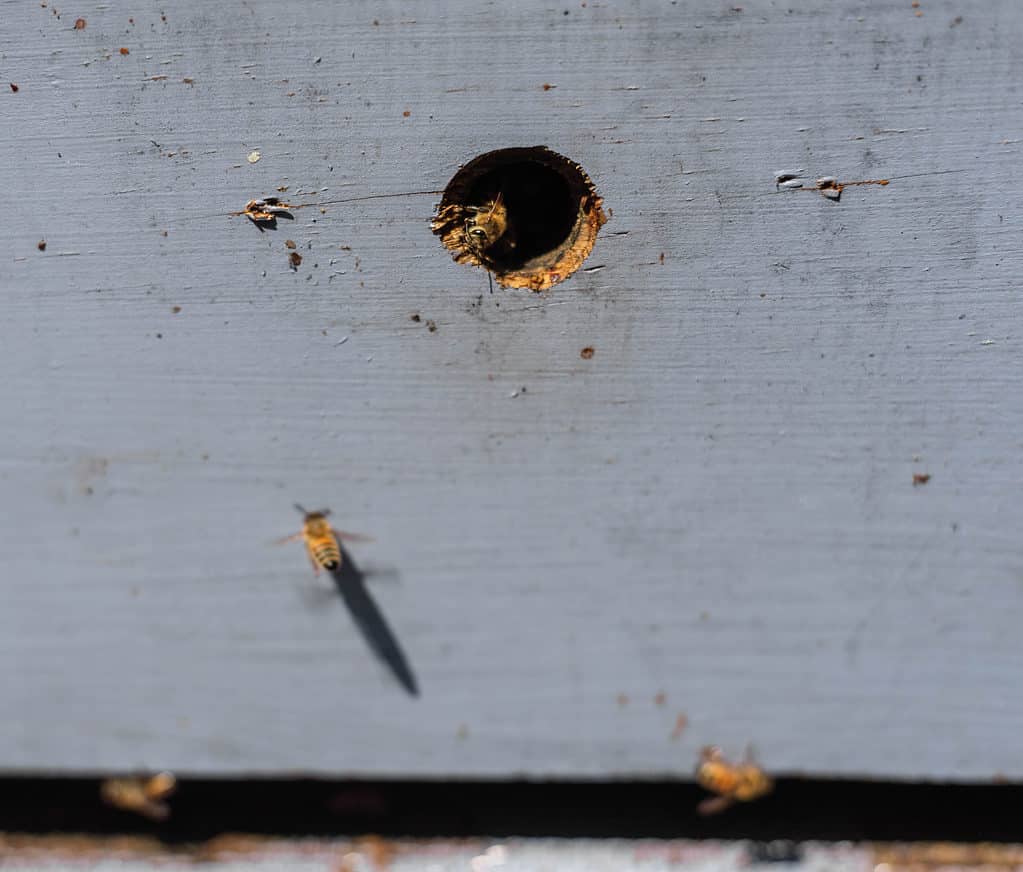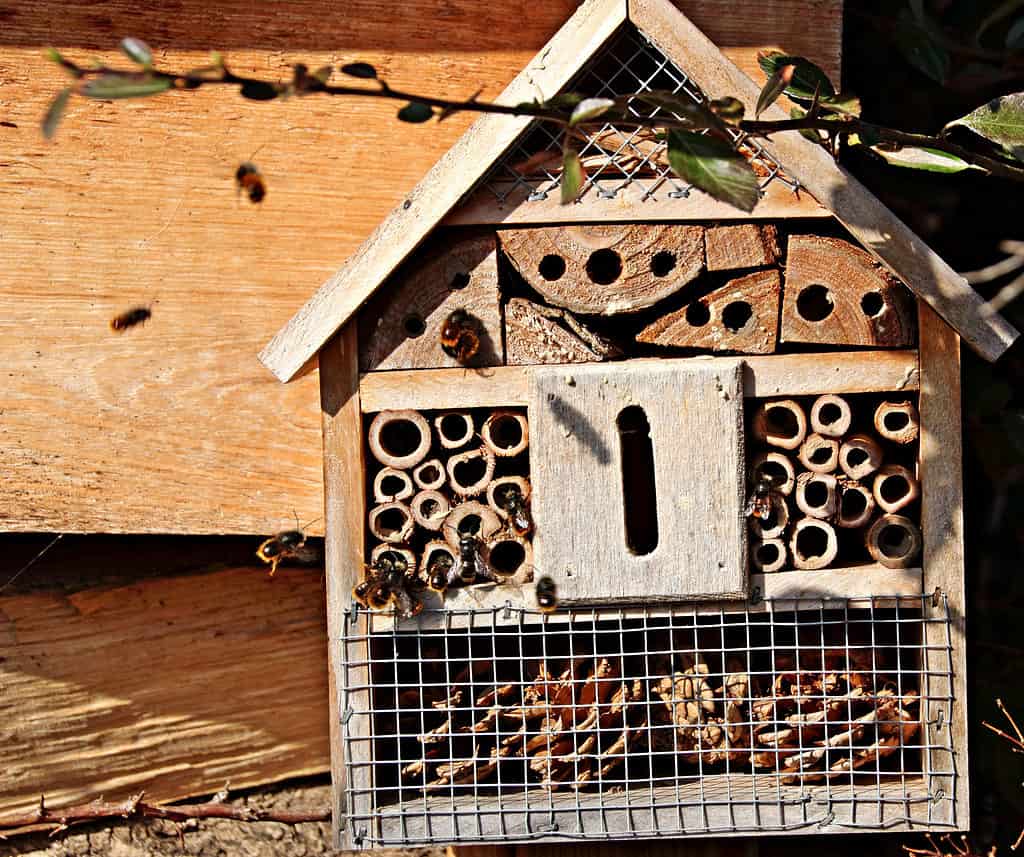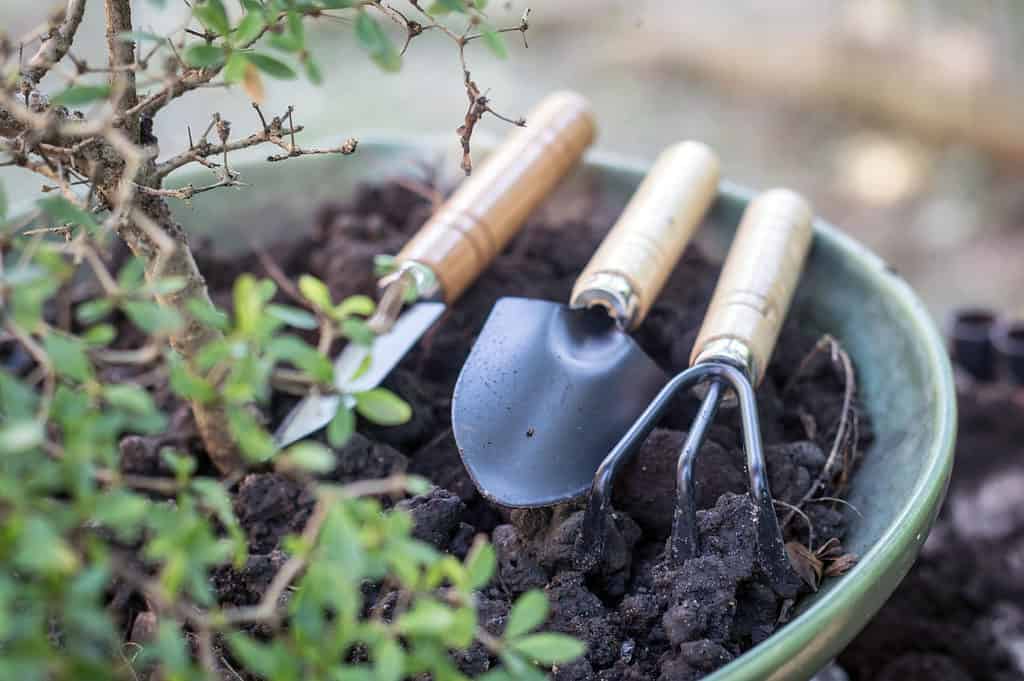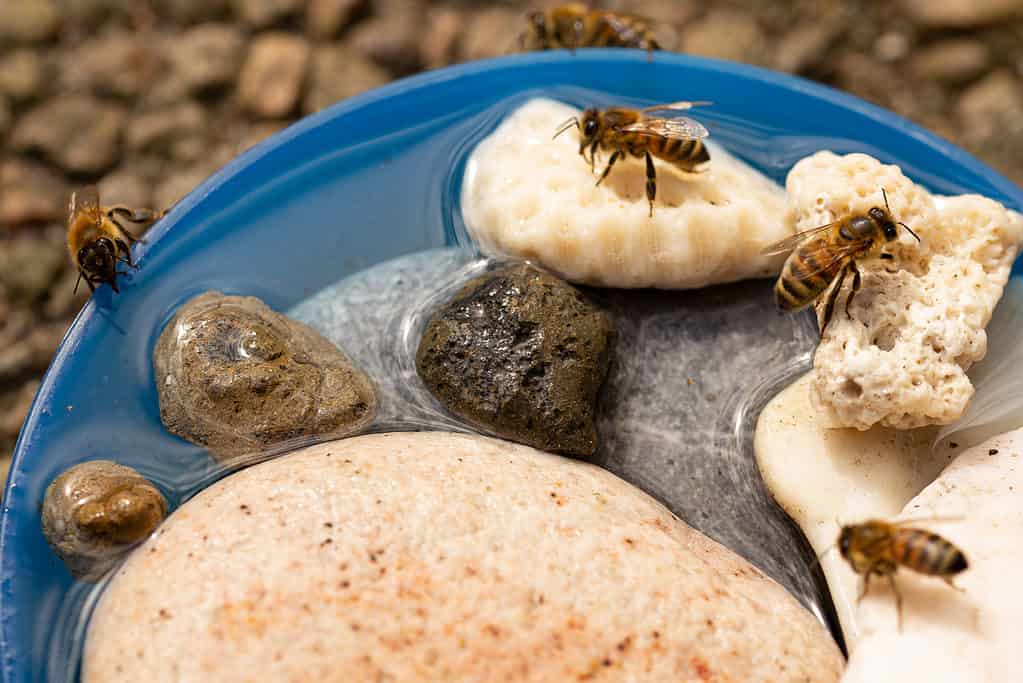Those buzzing beauties, showing off stripes of yellow and black or white and black or any number of other shades are more than just “friendly” insects for our gardens. Bees are a critical part of the ecosystem, the world over, and they’re in desperate need of protection and care.
Creating your own bee garden can be a huge help – even that tiny balcony, garden, yes! – and adding in some nesting grounds is an important component of that help.
If you’re ready to pitch in but aren’t quite sure what you need to do, this guide will provide you with ideas, suggestions, and even some suggested products and DIYs to help you create the ideal nesting grounds for your buzzing pals.
What Are Nesting Grounds and Why Should You Have Some?

©I. Rottlaender/Shutterstock.com
Technically, anywhere might become a bee nesting ground. However, if you’re trying to attract bees and improve their lives, providing them with a space set apart specifically for them to create homes is one of the best things you can do.
As the name indicates, nesting grounds are those spaces dedicated to allowing and encouraging bees to build or create homes. Bees are quickly losing their safe spaces around the planet as commercial properties and industries continue their deforestation, massive crops with insecticides, and many other practices. As individuals, we can help provide safe homes for bees in our gardens.
You’ll need to put in a little work to create the grounds and maintain them, but ultimately, it’s worth it in the end because you’re helping the planet by helping bees have a safe place to thrive.
To read more about why bee nesting grounds and bee gardens are so vital, read our full article on the topic.
Types of Bee Nests

©IanRedding/Shutterstock.com
There are more than 20,000 known species of bees around the world, with 4000 of them alone known to live in the United States. Because of this huge variety of species, there’s a huge variety of living styles these bees prefer. But there are five primary types of bee nests to be found around the world.
- Cavity nesters
- Ground nesters
- Wood and pitch nesters
- Renting nesters
- Architectural nesters
Cavity Nesters

©iStock.com/stacey_newman
According to the Xerces Society for Invertebrate Conservation, cavity bees make up 30% of native bees. These are the bees that lay their eggs in existing holes created by beetles or found in dead wood or create their own nesting chambers in pithy stems or hollow places. Some of them will also use human-created nesting blocks or cuttings designed for their use.
These nests contain brood chambers created by the bees that partition them via chewing the material around them to create the organized space. They then place a “bee bread” of pollen, honey, or nectar into each chamber where the eggs are laid so that the bee babies (known as larvae or pups, depending on the stage) have something to eat as they hatch and mature.
Ground Nesters

©iStock.com/Judy_Dautovich-Ralf_Hunsinger
While most folks think of bee hives dripping when honey when they picture nesting grounds for bees, those kinds of nests are actually far less common than ground nesting. Over 70% of the known bee species in the world create nests by digging in the ground and creating either underground nests or mound nests.
Different species of bees prefer different soil textures, which obviously you can’t fully accommodate, but if you have the option, you may offer a few textures to draw in more bees to the nesting grounds in your bee garden.
Ground nesting bees like any of the following:
- Clay soil mixes
- Hard-packed soils
- Silty soils
- Well-drained soils
- Sandy soils
The nests may be as shallow as a few inches while others may actually be 10 feet below ground. The nests may be close together or far apart, depending on the species and environment. If there are multiple nests together, they’re called nest aggregations and may become visible suddenly, seemingly overnight. In extreme cases, these aggregations may be huge (the largest ever found contained more than 12 million nests!) but in most cases in a private garden, they would only contain a handful of nests.
Bumble bees are ground nesters.
Wood and Pith Nesters
A much smaller group of bees make their nests in pithy stems and in wood, often decaying, older wood that is easy to bore into. They use their mandibles to dig into the wood and make their homes within.
Some of these bees will also adapt to other materials as their nests, like some that find themselves in areas without enough wood may burrow into dried horse manure or grass clumps.
“Renters”

©iStock.com/Alexander Ließ
Renting nesters, as they’re known, are the bees that don’t build or create their own nests but rather use existing structures to turn into their homes. These bees will use cracked stones, snail shells, burrows of other insects and animals, and human-made materials like straws, fencing, tubing, and window frame gaps.
These are the species that use bee hotels (more below on these). Once the bees mature enough to leave, they will remove the “covers” on their brood chambers and emerge. When the season shifts and the bees have all emerged, you’ll easily be able to see which chambers hatched eggs and which didn’t. You’ll need to clean out the ones that didn’t hatch to prevent disease or infestations of destructive insects.
Architects
Finally, some species build their own free-standing nests out of a range of materials. They’re known as architects because they design the nests using the local materials around them to create their unique homes. They’ll make these from resins, mud, stones mixed with resin or mud, plant fibers, hair, and animal fur.
Resin bees use their own natural secretions combined with plant matter and sappy-resin to create their hard shelled, water-resistant nests. They often decorate their nests, too, using stones and pebbles. So if you see a “pretty nest” like this, chances are that it belongs to resin bees.
Everything You Need for Bee Nesting Grounds

©iStock.com/Wirestock
Creating the bee nests and grounds isn’t difficult, as long as you have the right supplies on hand.
- Bee bath – make your own or purchase a pre-made option
- Bee hotel(s) or hive(s) if you’re working with a larger space
- Patches of uncovered soil for ground nesting bees
- Logs, branches, etc. for boring or pith nesting bees
- Natural fibers and materials – for architect bees
- Digging tools such as rakes, trowels, and hand cultivators
How Prepare Your Bee Nesting Grounds
You don’t – and probably couldn’t – cater to every single type of nesting space for the bees in your area. These many species prefer different things, which take up space which you may not have. You can create the environment that would be conducive to a large number of the species in your region, though, and that is probably your best option. Select the main nesting types in your area (such as resin bees or pith nesters) and create your bee nesting grounds to suit those select species.
Nesting Notes: Cavity Nests
To help encourage cavity nesters to take up residence in your bee garden, allow dead trees and branches to remain in your landscaping. You can position them in such a way that they are not distracting or obstructive.
A living plant that makes for a great option is raspberries. They have pithy stems that provide an excellent habit for smaller carpenter bees and similar cavity nesters.
Nesting Notes: Ground Nests
Ground nesting bees need access to bare earth. Avoid using mulch and fabrics in areas where bees are nesting as these will deter the bees from taking up residence. Instead, use compost as mulch.
Avoid tilling the soil in your bee garden, as well, as this can kill any nesting bees already present. Wait until bees emerge before tilling and do so less often to prevent harming these fruitful insects.
Skip pesticides and all chemicals in the bee garden, as well, whether you’ve got ground nesting or other types of bees. These chemicals can kill the bees, and ground nesters are particularly susceptible.
Nesting Notes: Bumble Bees
If you have bumble bees in your area, consider keeping a pile of clippings and woody plant materials in your garden for their nesting purposes. Leave behind leaf litter and plant ornamental grasses to provide these buzzers with nesting grounds.
Prepping the Garden

©wonderisland/Shutterstock.com
- The first step you’ll want to take in preparations is reading up on the types of bees that live in your area. Knowing which species are around can help you determine how much space to dedicate to the various types of habitats.
- Next, gather your supplies and tools, including plants specifically intended to provide nesting for bees, like raspberries or ornamental grasses.
- Plot out the spaces in the garden where there won’t be high traffic. You may wish to create a gentle pathway that allows you to go through the garden without disturbing the bees and still carefully work around them.
- Now, place bee hotels and bee baths according to the need of the size of your garden. Smaller gardens would do well with one each, while medium gardens will need a few each. If you have a large garden, add several, spread around, to ensure the bees have the space needed and provisions in those spaces. If you have a smaller garden but seem to invite a lot of bees in, you may want to add more hotels and baths.
- Be sure to leave some bare soil undisturbed for bee species that use compact earth for housing and gently turn soil for others, assuming you’ve seen no bee nests in the area already. Some of these nests look a bit like anthills while others simply look like holes in the ground.
- Plant your garden plants appropriately around the bee nesting grounds. For the plants to consider, read our list of plants that attract bees and for that step-by-step plan on building a full bee garden, check out the article.
Care for Your Bee Hotels
Once you’ve created your bee nesting grounds, you will need to maintain them, particularly bee hotels. In some cases, they may be prone to mold and issues, so it’s important to keep them clean.
- Clean out cells at the end of the summer that are still walled up. These cells contain eggs that did not hatch and should be cleaned to prevent illness or infestations of other insects.
- Clean out any larvae of flies or other insects. They eat pollen and bee larvae.
- Any drilled blocks in the hotel should be replaced every other year, during the summer, after the young bees have emerged. This prevents mold and fungus from growing.
Best Bee Hotels – Prefab and DIY Options

©Kaaca/Shutterstock.com
One of the most important components of your bee nesting grounds is the bee hotel or beehive. Thankfully, you don’t have to be handy to include some in your bee nesting grounds.
Wildlife World – Mason Bee Barrel
For mason bees, this bee barrel is an excellent and attractive choice for folks who don’t have time to make their own.
Outdoor Habitatz Hanging Geometric Mason Bee Hotels
Another simple option for hanging some mason bee housing in your nesting grounds is through the use of these geometric hotels. They’re much smaller than the barrel, as well, so they work for practically any size bee garden.
Elipark Versatile Bee Hotel
Providing spaces for many kinds of bees and nesting insects, this bee hotel from Elipark is a great choice for small and medium bee gardens.
Native Species Bee Hotel DIY
If you’d like to build your own bee hotel, this is a great option for intentional invitations to native species in your area.
Simple Bee House
Another simple DIY designed for easy manufacture and native species use comes can be made from this plan by UglyDucklingHouse.com.
No Tools Bucket Bee Hotel
From the Natural History Museum in the UK, this bucket bee hotel is an easy choice for someone who doesn’t have construction skills.
Bee Baths – Prefab and DIY Options

©BernadetteB/Shutterstock.com
Another necessary component of your bee nesting grounds is the bee bath. You may make your own or purchase some pre-made options.
Wildlife World Bee Bath
A simple bath you can add expanded clay or pebbles to easily turn into a bee bath is this simple, decorative option from Wildlife World.
Navaris Ceramic Bee Bath
For a colorful choice, this bee bath from Narvaris is a fun, easy option for gardens with a stand or stump where the bee bath could be placed.
Hanging Sunflower Bee Bath
For some extra attracting qualities, this bright yellow sunflower bee bath might do the trick. You’ll need to have a shepherd’s hook or similar for hanging it.
Kid-Friendly Bee Bath DIY
If the kids want to get involved, this DIY tutorial is designed specifically for their inclusion in the project.
Upcycled Bee Bath DIY
If you’d prefer to upcycle some materials from around the house, this DIY is a great choice.
Up Next:
- Honeybee
- Ashy Mining Bee
- Queen Bee vs. Worker Bee: What are the Differences?
- Honeybee Lifespan: How Long Do Honeybees Live?
The post Bee Nests: Your Guide to Creating Bee Nesting Grounds for Your Bee Garden appeared first on AZ Animals.
from Animal News, Facts, Rankings, and More! - AZ Animals https://ift.tt/ekb9mKp





